Are you a Quiet Speculation member?
If not, now is a perfect time to join up! Our powerful tools, breaking-news analysis, and exclusive Discord channel will make sure you stay up to date and ahead of the curve.
Combat is one of Magic's densest and most misunderstood areas. After all, the combat phase alone contains five separate steps! While much of what makes players "bad" at combat has to do with role analysis, game state awareness, board management, and simple arithmetic, understanding how combat functions on a technical level is also critical to navigating the phase gracefully.

Just a Phase focuses on the nuances of priority and phase manipulation in Modern. Last week's episode dealt with the upkeep and draw phases. This article tackles the five steps of combat (start of combat, declare attackers step, declare blockers step, damage step, and end of combat step), emphasizing which player is likeliest to act first in each step and detailing the reasons players act in them at all.
Acting in Start of Combat
The start of combat step contains no turn-based actions: players simply agree to enter it, receive a round of priority, and then move on to the declare attackers step. The defending player is more likely to have plays in this step, rendering it a solicitous speed-bump for the turn player.
Defender: Tapping Creatures; Skirting Triggers
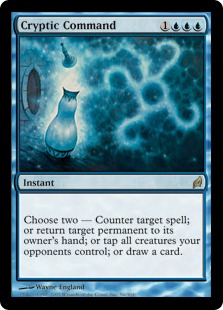 Even with Pestermite and Deceiver Exarch relegated to the sidelines, Modern is famous among non-rotating constructed formats for its start of combat antics. Today, those duties are largely fulfilled by Cryptic Command. The best time to tap someone's team is at start of combat, since they've already committed to the combat step at that point and can't elect to cast a hasty beater.
Even with Pestermite and Deceiver Exarch relegated to the sidelines, Modern is famous among non-rotating constructed formats for its start of combat antics. Today, those duties are largely fulfilled by Cryptic Command. The best time to tap someone's team is at start of combat, since they've already committed to the combat step at that point and can't elect to cast a hasty beater.
Avoiding triggers is another reason defending players act here. Some creatures activate their abilities when they attack, like Signal Pest and Smuggler's Copter. These should be snapped off before they get the chance to.
Lastly, some effects require creatures to attack. Ghor-Clan Rampager is the big one here. It feels pretty bad to Lightning Bolt a Wild Nacatl only to have it become 7/7 via Ghor-Clan Rampager. Or to Fatal Push a lone Insectile Aberration only for its grinning pilot to slam a "kicked" Chart a Course. Start of combat is the phase to play around these cards.
Attacker: Baiting Interaction; Activating Relevant Triggers/Abilities
Most of the instant-speed plays the turn player could make in this step are better suited to the main phase, which gives them more options with their fresh round of priority should opponents react (specifically, sorcery-speed options). So players looking to enter combat are probably game to jump straight into attacks. That makes the start of combat step something of a minefield navigation, most eloquently encapsulated by the tentative, Twin-era proposal of "combat?"
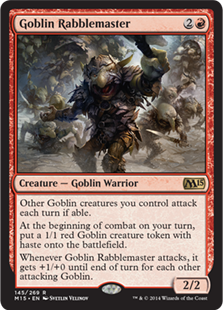 While "combat?" once meant "attacks?", it now means, "may we leave the main phase and enter combat?" Then, active players are likely to ask opponents if they're prepared to go all the way to attacks. This particular question is the one that elicits moves like Cryptic tap-draws and pre-attack removal spells.
While "combat?" once meant "attacks?", it now means, "may we leave the main phase and enter combat?" Then, active players are likely to ask opponents if they're prepared to go all the way to attacks. This particular question is the one that elicits moves like Cryptic tap-draws and pre-attack removal spells.
Of course, the primary stated purpose of this rules change was to give active players an easy way to activate triggers and abilities during start of combat with their priority. Think crewing last turn's Smuggler's Copter with a fresh Goblin Rabblemaster token. As of yet, though, these cases don't surface much in Modern, and attackers generally use this phase to bait interaction. Combat-relevant activations such as turning on Mutavault are likelier to occur either in the precombat main phase or after opponents make a move in start of combat.
Acting in Attacks
In the declare attackers step, the active player declares their attacks, and then both players receive priority. Since the active player makes the first move in this step by declaring attackers, priority is usually passed to the defender right away, with active players opting to act only after seeing how opponents choose to navigate the rest of combat.
Defender: Scouting for Information
Defensive actions in attacks are quite common. This step is the first in which defenders can make plays after opponents have locked themselves into certain attacks. The biggest reason they'd remove creatures or take other actions here, and not later, is to harvest information, usually about how to block. If the attacking player has blue mana up and cards in hand, defenders might be worried about permission, and want to test the waters with removal spells before deciding on blocks. Otherwise, they may block the wrong creature, or with the wrong creature.
Attacker: Locking In Attacks
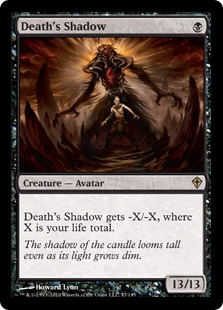 The active player also receives an opportunity to act in this step before opponents do, but will rarely want to. It's not exactly common in Modern for players to slam Keep Watch after swinging in hopes of drawing removal for blockers. Still, that's the kind of niche scenario such actions demand.
The active player also receives an opportunity to act in this step before opponents do, but will rarely want to. It's not exactly common in Modern for players to slam Keep Watch after swinging in hopes of drawing removal for blockers. Still, that's the kind of niche scenario such actions demand.
A frequent use for active actions in attacks would be to lock in attacks against opponents with tap effects before revealing additional information. For example, against this silly Grixis Shadow build, Jund pilots might pass priority up to attacks to bait a Cryptic Command tap-draw in start of combat. If that doesn't occur, perhaps because Grixis is already holding down the ground with a huge Death's Shadow, the active player can declare two Tarmogoyfs as attackers and then Abrupt Decay the Shadow before blocks, all but guaranteeing a Goyf hit.
Acting in Blocks
With blocks determined, players receive what could be the last chance to make a move before damage is dealt—should the attacker pass priority in this step, and their opponent choose to do the same, damage will occur.
Attacker: Reacting to Blocks
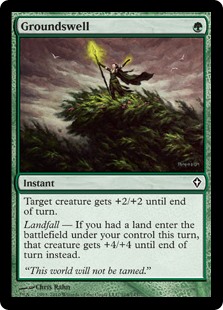 Active players are the likeliest to act in this step. They can leverage complete knowledge of all battling creatures for the first time, and are first to receive priority with that information available. Removing single potential blockers is usually a task reserved for earlier in the turn, such as during attacks or in the main phase; otherwise, those creatures get to block!
Active players are the likeliest to act in this step. They can leverage complete knowledge of all battling creatures for the first time, and are first to receive priority with that information available. Removing single potential blockers is usually a task reserved for earlier in the turn, such as during attacks or in the main phase; otherwise, those creatures get to block!
But removal spells still fly during blocks, especially to punish greedy double-blocks. Killing one creature with Fatal Push usually enables a heavy-hitter to chew through the other. Gunning down creatures set up in front of trampling attackers is equally viable, as trample damage goes through regardless of whether an attacker is marked as blocked. Lastly, attackers may want to sling pump spells with blocks established, loading up the lone unblocked creature with Groundswells or +1/+1 counters from an Arcbound Ravager. Ghor-Clan Rampager and Temur Battle Rage also improve drastically when cast in this step.
Defender: Locking In Blocks
As with active player actions in attacks, defensive players rarely initiate action in this step. After all, attackers receive priority first, so they may well choose to act before defenders even get a chance. But again, the most common reason for defending players to act in blocks is guaranteeing blocks prior to making moves that might persuade opponents to interact with their blockers.
For example, say the defending player plans to block a 5/5 Gurmag Angler with their 3/4 Tarmogoyf, but is holding Mutagenic Growth. The line is to block Angler, and then Grow Goyf; if Goyf is grown first, opponents can kill it before it ever jumps in front of the fish, meaning the defender takes 5 damage for nothing and also loses a card to poor sequencing (such situations are often called "blowouts").
Acting in Damage and End of Combat
In the damage step, two turn-based actions occur before players receive priority: the attacking player assigns damage to blockers and players, and then damage is dealt. Afterwards, players receive priority, and do so again in the redundant end of combat step.
Defender: Altering Game State Before Main 2
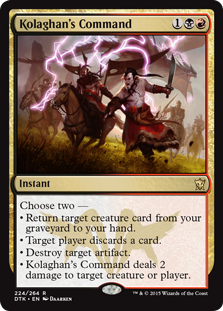 With damage out of the way and new creatures in the graveyard, the turn's next step is the postcombat main phase. Before that, though, players can act. The nonactive player must act at instant speed for the duration of their opponent's turn, and so is incentivized to alter the game state now; once the turn has moved into main 2, the active player has priority to play cards at sorcery speed. Using Kolaghan's Command to discard their final card before they get a chance to cast it is a good example of a strong damage step play.
With damage out of the way and new creatures in the graveyard, the turn's next step is the postcombat main phase. Before that, though, players can act. The nonactive player must act at instant speed for the duration of their opponent's turn, and so is incentivized to alter the game state now; once the turn has moved into main 2, the active player has priority to play cards at sorcery speed. Using Kolaghan's Command to discard their final card before they get a chance to cast it is a good example of a strong damage step play.
For a more concrete example, take a game I piloted recently against Counter-Cat (now back on Mutaganic Growth over Disrupting Shoal, for those curious) with Colorless Eldrazi Stompy. Thought-Knot Seer traded with an attacking Hooting Mandrills, and I cracked Relic of Progenitus in response to my creature's leaves-the-battlefield trigger. This way, should my opponent draw another Hooting Mandrills off the Seer, they won't be able to cast it in main 2; should they draw Snapcaster Mage, there won't be any targets in the graveyard. I definitely wanted the draw from Relic that turn anyway, so it made sense to crack it at the moment where it was most likely to disrupt my opponent.
Attacker: Manipulating Triggers
The active player probably wants to get out of the combat step and act in main 2, where their opponent has fewer options than them. But they may still act in the damage step depending on triggers that occur in the main phase. For instance, after swinging with Geist of Saint Traft, the active player might want to fire off a ferocious spell like Feed the Clan; by main 2, their 4/4 Angel will have vanished.
Addressing End of Combat
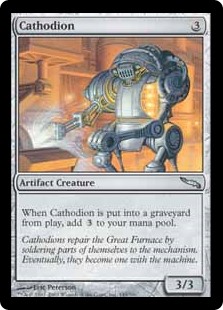 Unlike the supremely useful start of combat step, the end of combat step is mostly superfluous. Since no turn-based actions occur in this step, it exists solely to give players one last round of priority before the postcombat main phase. But actions players might want to take in this step could also be taken during the damage step. The most obvious use, at least on paper, for moving to end for an action is to empty an opponent's mana pool that somehow filled up during damage (say, by trading their Cathodion for a Wild Nacatl). That said, if opponents have something to do with 3 mana, they also have little reason to wait until end of combat to make that play rather than just firing it off in damage.
Unlike the supremely useful start of combat step, the end of combat step is mostly superfluous. Since no turn-based actions occur in this step, it exists solely to give players one last round of priority before the postcombat main phase. But actions players might want to take in this step could also be taken during the damage step. The most obvious use, at least on paper, for moving to end for an action is to empty an opponent's mana pool that somehow filled up during damage (say, by trading their Cathodion for a Wild Nacatl). That said, if opponents have something to do with 3 mana, they also have little reason to wait until end of combat to make that play rather than just firing it off in damage.
End of Combat Phase Article
In my experience, anyone from game newcomers to Magic veterans can stand to benefit from a little more phase-related awareness, and combat is the richest phase of them all. In the third and final installment of Just a Phase, we'll cover main 1 and 2 and the end step. Until then, if you can think of a practical use for the end of combat step in Modern, drop me a line in the comments.




Good article Jordan! I just wanted to chime in and say that the end of combat step can be important when playing against Infect. A lot of times you’re fine taking some poison as long as it isn’t lethal, then play a card like Blessed Alliance.
What’s the difference between casting BA during end of combat and during damage step?
I think this case in point for example: opponent swings with enchantment-laden Bogle and 1/1 Warrior that comes from cartouche to navigate Sacrifice effects. Defender blocks 1/1 warrior, then casts Blessed Alliance in end of combat phase.
Can still cast BA in damage step for the exact same effect! By the time you receive priority there to cast spells, the Warrior has been killed.
The one niche where this seems like it would matter is waiting until after tokens go away. Maybe your opponent attacks with Geist of Saint Traft and something else; you block and kill the something else; after the angel token is exiled, there is a window for sac effects like Blessed Alliance. Surely not a common situation, which is why it’s fair to say that step is usually redundant.
Oh, that’s true! Killing Geist after the Angel token dies… so I guess this could possibly come up in the Jeskai Geist mirror match?! Good thinking 🙂
Seems better to cast BA in response to the angel trigger though…
You could need to block something else first I guess. It’s niche!
Hej Jordan!
Thanks for the second article in this series.
I was surprised to not see the interaction between manlands and cryptic command being explained in this article. You feel it’s not actually part of the combat phase itself, too niche or too well known already?
Looking forward to your reply 🙂
“Combat-relevant activations such as turning on Mutavault are likelier to occur either in the precombat main phase or after opponents make a move in start of combat.”
Yes, there’s a short line in there. But I felt that it was easily overlooked when not giving an example. I feel that tapping with Cryptic is the most well known one and an important one to know for people starting in Modern.
That being said, this is an article on the phases not specific interactions. Not to mention that the article might get way too long if you give an example for everything.
I agree that this example is very well-known, and perhaps the best-known explicit manipulation of phases in Modern. That’s why I felt it would suffice to reference it in passing, allowing me to dedicate more time to lesser-known interactions and relatively unexplored space.
For the record, though, I did call out the interaction more explicitly a bit above the last passage I quoted:
“Even with Pestermite and Deceiver Exarch relegated to the sidelines, Modern is famous among non-rotating constructed formats for its start of combat antics. Today, those duties are largely fulfilled by Cryptic Command. The best time to tap someone’s team is at start of combat, since they’ve already committed to the combat step at that point and can’t elect to cast a hasty beater.”
IMO, there isn’t much more to say about the interaction than that regardless!